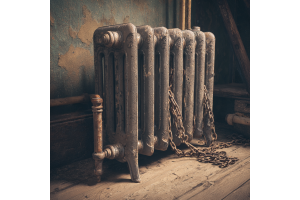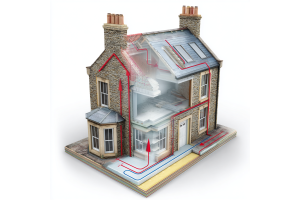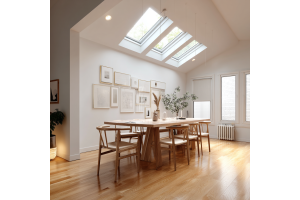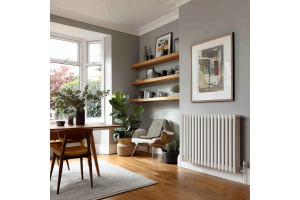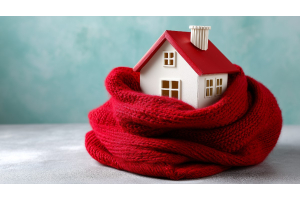
When it comes to choosing the right radiator for your kitchen, functionality and style are equally important. Kitchens are often busy, multi-functional spaces where wall space is at a premium. That’s why vertical radiators are the ideal choice for kitchens, offering efficient heating without compromising your layout or design.
The kitchen is often the heart of the home, where families gather, meals are prepared, and social interactions take place. However, keeping a kitchen warm and comfortable can be challenging due to factors like fluctuating temperatures from cooking, limited wall space due to cabinets, and the need for efficient heating solutions that complement the room's aesthetic.
Selecting the right radiator for your kitchen requires considering functionality, design, energy efficiency, and space optimization. This guide will help you navigate the best radiator options available, ensuring that your kitchen remains a warm and inviting space year-round.
Understanding the Unique Heating Needs of a Kitchen
The kitchen is one of the most frequently used rooms in any home, often serving as a social hub where family and friends gather. However, it also has unique heating challenges that must be considered when selecting the right radiator. Unlike other rooms, kitchens are exposed to fluctuating temperatures due to cooking activities, the presence of appliances that generate heat, and potential ventilation systems like extractor fans. This means choosing a radiator that efficiently complements the existing heat sources without overpowering the space or making it uncomfortable.
a. Managing Heat Fluctuations
Cooking generates a significant amount of heat, and the warmth from ovens, hobs, and even dishwashers can raise the room temperature considerably. As a result, the radiator’s role in a kitchen is often to maintain a consistent base level of warmth rather than providing the primary source of heat. A smart or thermostatic radiator valve (TRV) can help regulate temperature fluctuations, ensuring the radiator only operates when needed.
b. Maximizing Space Efficiency
Many kitchens have limited wall space due to cabinets, countertops, and built-in appliances. Unlike living rooms or bedrooms, where traditional horizontal radiators fit comfortably, a kitchen may require space-saving solutions like vertical radiators, underfloor heating, or compact models that can fit into tighter areas without disrupting the kitchen layout.
c. Moisture Resistance and Durability
Kitchens experience higher levels of moisture, humidity, and occasional spills. Radiators in this environment must be made from corrosion-resistant materials such as stainless steel, aluminium, or treated mild steel to prevent rust and degradation over time. Powder-coated finishes or specially treated designs can also enhance durability in a high-humidity environment.
d. Energy Efficiency Considerations
Since the kitchen generates additional heat from appliances, an energy-efficient radiator that adjusts its output accordingly is an excellent choice. Smart radiators or models with low water content (such as aluminium radiators) heat up quickly and cool down rapidly, preventing unnecessary energy consumption.
By understanding the unique heating challenges of a kitchen, homeowners can choose the most effective radiator type that balances heat efficiency, space optimization, and durability, ensuring a comfortable and practical kitchen environment.
1. Key Considerations When Choosing a Kitchen Radiator
Before selecting a radiator for your kitchen, it’s important to assess several factors that will influence your choice:
a. Space and Layout Constraints
-
Kitchens often have limited wall space due to cabinets, countertops, and appliances. Opting for compact or vertical radiators can help maximize available space.
-
Consider placing radiators under worktops, near dining areas, or on walls with minimal cabinetry.
-
If floor space is scarce, wall-mounted, plinth, or recessed radiators can be ideal solutions.
-
Open-plan kitchens may require a more powerful radiator or multiple heat sources to distribute warmth effectively.
b. Heat Output Requirements
-
The heat output of a radiator is measured in British Thermal Units (BTUs), which indicates how much heat a radiator will emit to warm up a room.
-
Kitchens have additional heat sources (ovens, stovetops, and other appliances), which means the required BTU output might be lower than in other rooms.
-
A well-insulated kitchen with double-glazed windows and proper ventilation will need a lower BTU rating than a kitchen with drafts or poor insulation.
-
Using an online BTU calculator or consulting with a heating professional can help determine the most suitable radiator size.
c. Moisture and Hygiene Factors
-
Kitchens generate a lot of moisture and grease, which can affect the longevity and cleanliness of radiators.
-
Opt for corrosion-resistant materials like stainless steel, aluminium, or powder-coated finishes that resist rust and wear in humid conditions.
-
Radiators with smooth, easy-to-clean surfaces are ideal for kitchens, as they minimize grease buildup and ensure better hygiene.
-
Avoid traditional radiators with intricate designs that can trap dust and grime, making them harder to maintain.
d. Energy Efficiency
-
Energy-efficient radiators ensure that you are reducing energy consumption and keeping heating costs low.
-
Consider radiators with thermostatic radiator valves (TRVs), which allow temperature control on an individual basis.
-
Smart heating options, such as Wi-Fi-controlled and programmable radiators, enable users to set specific heating schedules for optimal efficiency.
-
Aluminium radiators heat up quickly and require less energy to reach the desired temperature, making them an eco-friendly choice.
e. Aesthetic Appeal
-
Since the kitchen is a highly visible and social space, choosing a stylish radiator that complements the decor is crucial.
-
Modern designer radiators, available in various colors, materials, and finishes, can enhance the kitchen’s overall look.
-
Vertical and slimline radiators add a sleek, contemporary touch, while traditional cast-iron radiators suit rustic or period-style kitchens.
-
Custom-painted radiators can blend seamlessly with kitchen cabinetry or serve as a statement piece in bold colors.
By considering these key factors, you can select a radiator that balances practicality, energy efficiency, and visual appeal, ensuring your kitchen remains a warm and welcoming space throughout the year.
2. Best Types of Radiators for Kitchens
Choosing the right radiator for your kitchen involves considering factors such as heat output, available space, aesthetics, and efficiency. Since kitchens have different heating requirements compared to other rooms, selecting the most suitable type of radiator is essential for maintaining comfort without wasting energy. Below, we explore the best radiator types for kitchens and their advantages.
a. Vertical Radiators – The Perfect Space-Saving Solution
One of the biggest challenges in a kitchen is limited wall space due to cabinets, appliances, and countertops. Traditional horizontal radiators can be difficult to accommodate, which is why vertical radiators have become a popular solution.
Why Choose a Vertical Radiator for Your Kitchen?
-
Takes up less horizontal wall space, leaving more room for storage and appliances.
-
Provides high heat output while maintaining a sleek, modern aesthetic.
-
Can be installed in narrow gaps or beside tall units.
-
Available in designer styles, making them a stylish feature rather than just a heating element.
A vertical radiator is an ideal option for kitchens with limited wall space but high heating demands.
b. Plinth Heaters – The Discreet Under-Cabinet Option
For those looking to save even more space, plinth heaters (also known as kick-space heaters) are an innovative alternative to traditional radiators. These units are fitted into the plinth (kickboard) beneath kitchen cabinets, distributing warm air efficiently without taking up valuable wall space.
Advantages of Plinth Heaters:
-
Perfect for small kitchens where every inch of space counts.
-
Uses a fan-assisted system to quickly warm up the room.
-
Can be connected to your central heating system or work independently as an electric heater.
-
Operates with low energy consumption, making them an energy-efficient choice.
Plinth heaters are an excellent option for modern kitchens where floor and wall space are limited, offering effective warmth without compromising aesthetics.
c. Towel Radiators – Adding Warmth and Functionality
Towel radiators, or heated towel rails, are typically associated with bathrooms, but they can also be a practical and stylish choice for kitchens. These radiators provide warmth while doubling as a convenient place to hang kitchen towels, tea towels, or even small dishcloths.
Why Consider a Towel Radiator for Your Kitchen?
-
Provides gentle, continuous heat without overheating the space.
-
Acts as a multi-functional fixture for warming towels and drying damp dishcloths.
-
Available in a range of designs and finishes to suit modern or traditional kitchens.
-
Compact and can be mounted on unused wall spaces or near the sink area.
A towel radiator is a great secondary heating option that combines style, efficiency, and practicality in the kitchen.
d. Panel Radiators – A Classic and Efficient Choice
For those who prefer a traditional yet effective heating option, panel radiators remain a reliable choice. These radiators provide high heat output and are available in single, double, or triple panel configurations, depending on the heating needs of your kitchen.
Benefits of Panel Radiators:
-
Versatile and available in a range of sizes and designs.
-
Can be installed beneath windows to counteract cold drafts.
-
High heat output, making them suitable for larger kitchens.
-
Budget-friendly, offering excellent efficiency at a lower cost.
Panel radiators are ideal for kitchens with adequate wall space and a need for consistent warmth, making them a cost-effective and efficient solution.
e. Electric Radiators – A Flexible and Modern Heating Solution
If your kitchen doesn’t have a connection to the central heating system, or you need supplementary heat, electric radiators can be a fantastic option. They provide on-demand heating and can be easily installed without plumbing work.
Why Choose an Electric Radiator for Your Kitchen?
-
Can be operated independently of the central heating system.
-
Instant heat with precise temperature control.
-
Available in modern, space-saving designs, including wall-mounted and freestanding models.
-
Perfect for extensions, conservatories, or kitchens with underfloor heating as a primary source.
Electric radiators are energy-efficient and flexible, making them an excellent option for homeowners looking for modern, controllable heating in the kitchen.
f. Underfloor Heating – The Ultimate Luxury & Space-Saving Solution
For those seeking unobtrusive yet effective heating, underfloor heating is an excellent investment. It provides even heat distribution throughout the kitchen, eliminating the need for traditional radiators while keeping the space warm and comfortable.
Advantages of Underfloor Heating in Kitchens:
-
Completely hidden – no need for wall-mounted radiators.
-
Even heat distribution, eliminating cold spots.
-
Works well with tiles, stone, and laminate flooring (common kitchen materials).
-
Available in both wet (water-based) and electric (dry) systems.
While installation costs can be higher, underfloor heating is a long-term, energy-efficient solution that adds a touch of luxury to any modern kitchen.
Final Thoughts on Choosing the Best Kitchen Radiator
When selecting a radiator for your kitchen, it’s important to consider space limitations, heating efficiency, and aesthetics. Whether you opt for a vertical radiator, a discreet plinth heater, a stylish towel radiator, or luxurious underfloor heating, the key is to choose a solution that complements your kitchen layout while providing optimal warmth.
By understanding the unique needs of a kitchen and exploring the various radiator options available, you can create a space that is both functional and comfortable without compromising on design
3. Best Materials for Kitchen Radiators – Durability, Performance, and Aesthetics
Choosing the right material for your kitchen radiator is crucial for ensuring efficiency, durability, and resistance to moisture, grease, and temperature fluctuations. Kitchens present a unique environment, with high humidity, steam, and occasional splashes from cooking activities. Some materials perform better in this setting than others, so understanding their heat retention, corrosion resistance, and maintenance requirements will help you make the best choice.
Below, we explore the most common radiator materials and their suitability for kitchens.
a. Aluminium Radiators – Lightweight, Fast Heating, and Energy Efficient
Best for: Modern kitchens, energy-conscious homeowners, quick heating needs.
Why Choose Aluminium?
-
Quick Heat-Up Time → Aluminium has excellent thermal conductivity, meaning it heats up and cools down faster than other materials. This makes it ideal for kitchens, where heating may only be needed at certain times of the day.
-
Energy Efficient → Since aluminium radiators react quickly to thermostat changes, they use less energy compared to cast iron or steel.
-
Lightweight and Easy to Install → Perfect for wall-mounted or vertical radiators, which are ideal for kitchens with limited space.
-
Corrosion-Resistant → Unlike mild steel, aluminium does not rust easily, making it a great choice for high-humidity environments.
-
Modern Designs → Available in sleek, minimalist styles that blend seamlessly into contemporary kitchens.
Potential Downsides:
-
Can be more expensive than mild steel radiators.
-
Does not retain heat as long as cast iron after the heating is turned off.
b. Stainless Steel Radiators – Corrosion Resistance and Long-Lasting Performance
Best for: High-humidity kitchens, modern and industrial-style kitchens.
Why Choose Stainless Steel?
-
Extremely Durable → Stainless steel radiators last decades and are resistant to rust and corrosion, making them perfect for kitchens with high moisture levels.
-
Excellent Heat Retention → Though they take a bit longer to warm up than aluminium, they stay hot for a long time, making them efficient for maintaining warmth in a frequently used space.
-
Modern and Stylish → Often available in brushed, polished, or matte finishes, stainless steel radiators look great in modern, minimalist, or industrial-style kitchens.
-
Low Maintenance → Easy to clean and resistant to grease and stains.
Potential Downsides:
-
More expensive than mild steel and aluminium due to its durability and corrosion resistance.
-
Takes longer to heat up compared to aluminium, but this is offset by its excellent heat retention.
c. Cast Iron Radiators – Classic Design and Long-Lasting Heat
Best for: Traditional or farmhouse-style kitchens, homes with consistent heating.
Why Choose Cast Iron?
-
Exceptional Heat Retention → Cast iron radiators stay warm for a long time, even after the heating is turned off, making them a cost-effective choice for continuous warmth.
-
Classic Aesthetic Appeal → Perfect for traditional, vintage, or rustic kitchens, cast iron radiators add an elegant, old-world charm.
-
Durability → With proper maintenance, a cast iron radiator can last decades or even generations.
Potential Downsides:
-
Slow to Heat Up → Takes longer to reach optimal temperature compared to aluminium or steel.
-
Heavy and Difficult to Install → Not ideal for wall-mounted applications, which may limit placement options in smaller kitchens.
-
Requires Regular Maintenance → Needs occasional painting or rust treatment if not properly coated.
d. Mild Steel Radiators – Affordable and Versatile
Best for: Budget-friendly options, a wide range of styles and finishes.
Why Choose Mild Steel?
-
Affordable and Widely Available → The most common radiator material, available in many designs, including vertical, horizontal, and towel radiators.
-
Wide Range of Colors and Finishes → Easily customizable to match any kitchen interior, from modern to traditional.
-
Good Heat Output → Provides consistent warmth at an affordable price.
Potential Downsides:
-
Prone to Corrosion → If not properly coated or treated, mild steel can rust over time, especially in humid kitchen environments.
-
Lower Heat Retention → Does not hold heat as well as cast iron or stainless steel.
Pro Tip: To prevent rusting, choose powder-coated mild steel radiators with an anti-corrosion finish.
e. Glass and Mirrored Radiators – Stylish and Space-Saving Solutions
Best for: Small kitchens, ultra-modern spaces, space-saving heating solutions.
Why Choose Glass or Mirrored Radiators?
-
Aesthetic Appeal → Sleek, reflective surfaces make them perfect for high-end, contemporary kitchens.
-
Multi-Functional → Mirrored radiators serve as both a heat source and a reflective surface, making them great for small kitchens where space is limited.
-
Wall-Mounted and Discreet → Ideal for open-plan kitchens or minimalist designs.
Potential Downsides:
-
Lower Heat Output → Generally less powerful than steel or aluminium radiators.
-
Fragile → Though made from toughened glass, they can still crack under extreme impact.
Final Thoughts on the Best Materials for Kitchen Radiators
Choosing the right radiator material depends on your kitchen's size, humidity levels, budget, and design preferences.
Best Overall for Modern Kitchens: Aluminium or Stainless Steel – Energy-efficient, corrosion-resistant, and available in sleek designs.
Best for Traditional Kitchens: Cast Iron – Classic, long-lasting warmth but requires space and regular maintenance.
Best for Budget-Friendly Options: Mild Steel – Affordable and versatile, but may require anti-rust coatings.
Best for Small Kitchens: Glass or Mirrored Radiators – Stylish and space-saving, though with lower heat output.
By carefully selecting the best material, you can ensure longevity, efficiency, and a beautiful addition to your kitchen while keeping your space warm and comfortable all year round.
4.Smart Heating Options for Kitchens – Efficiency, Control, and Convenience
Modern kitchens are more than just cooking spaces—they're multifunctional hubs where families gather, entertain guests, and spend time together. With the growing demand for energy efficiency, automation, and convenience, smart heating solutions have become a game-changer.
Smart radiators and heating systems allow homeowners to optimize temperature control, reduce energy waste, and enhance comfort in their kitchens. In this section, we’ll explore the best smart heating options for kitchens, including Wi-Fi-enabled radiators, programmable thermostats, zoned heating, and voice-controlled integration.
a. Wi-Fi-Enabled Radiators – Remote Control and Efficiency
Best for: Busy households, tech-savvy homeowners, energy-conscious users.
What Are Wi-Fi-Enabled Radiators?
Wi-Fi-enabled radiators connect to your home’s wireless network, allowing you to control heating remotely using a smartphone, tablet, or computer. These radiators are perfect for kitchens because they provide precise temperature management, ensuring warmth only when needed.
Benefits of Wi-Fi Radiators in Kitchens:
-
Remote Control → Adjust the temperature from anywhere using an app.
-
Energy Savings → Avoid heating an empty kitchen unnecessarily.
-
Scheduling Features → Program the radiator to turn on before meal prep or family gatherings.
-
Multi-Zone Heating → Control the kitchen’s temperature separately from other rooms.
Potential Downsides:
-
Requires a stable Wi-Fi connection.
-
Initial cost is higher than traditional radiators.
Popular brands include Ecostrad iQ, Stelrad Vita, and Rointe D Series, which offer smart heating control and energy efficiency.
b. Programmable Thermostats – Precision Heating Control
Best for: Households looking for automated heating schedules.
What Are Programmable Thermostats?
A programmable thermostat lets you set a predefined heating schedule, automatically adjusting the temperature at different times of the day.
Why It Works Well in Kitchens:
-
You can program the heating to turn on during breakfast and dinner hours while keeping it off when the kitchen is not in use.
-
Temperature fluctuations are managed efficiently, ensuring consistent warmth.
-
Some models offer adaptive learning, adjusting heat output based on your habits.
Potential Downsides:
-
Requires proper setup to maximize efficiency.
-
Not as flexible as fully smart thermostats with remote control.
Popular options include Honeywell T6, Nest Learning Thermostat, and Hive Active Heating.
c. Zoned Heating – Controlling Different Areas Independently
Best for: Large homes, open-plan kitchens, and energy-conscious users.
What Is Zoned Heating?
Zoned heating divides your home into independent temperature-controlled areas, so your kitchen can have a different setting than the living room or bedrooms.
Benefits of Zoned Heating in Kitchens:
-
Heats only the rooms in use, reducing energy waste.
-
Different temperatures for different spaces—your kitchen can be cooler than your lounge area.
-
Compatible with smart radiators and thermostats for full automation.
Potential Downsides:
-
Requires compatible heating systems and smart valves.
-
Installation can be costly if retrofitting.
A great way to implement zoned heating is with Thermostatic Radiator Valves (TRVs), which allow each radiator to be individually controlled.
d. Voice-Controlled Heating – Hands-Free Operation for Busy Kitchens
Best for: Tech-savvy homeowners, smart home enthusiasts, people who frequently cook.
What Is Voice-Controlled Heating?
Many smart radiators and thermostats can now integrate with voice assistants like Amazon Alexa, Google Assistant, or Apple HomeKit, allowing you to control your kitchen’s heating with simple voice commands.
Examples of Voice Commands for Heating:
-
"Alexa, set the kitchen radiator to 21°C."
-
"Hey Google, turn off the kitchen heating."
-
"Siri, lower the temperature in the kitchen by 2 degrees."
Potential Downsides:
-
Requires compatible smart devices.
-
May not be necessary for smaller homes with single-zone heating.
Smart thermostats like Nest, Tado, and Hive work seamlessly with voice control systems for effortless heating management.
e. Smart Sensors and Motion-Activated Heating
Best for: Energy efficiency, automatic control, and convenience.
What Are Smart Heating Sensors?
Smart heating sensors detect room occupancy, temperature fluctuations, and even humidity levels, adjusting the radiator’s output accordingly.
Why They Work Well in Kitchens:
-
Automatically turns on/off based on movement, ensuring warmth when the space is in use.
-
Prevents overheating in small kitchens, where cooking appliances generate extra warmth.
-
Humidity sensors help maintain air quality and prevent condensation issues.
Potential Downsides:
-
Some systems require professional installation.
-
Initial investment can be higher than standard heating solutions.
Smart sensor brands like Eve Room, Netatmo Smart Sensors, and Fibaro Motion Sensor offer real-time monitoring and automation.
Final Thoughts on Smart Heating for Kitchens
Investing in smart heating solutions for your kitchen enhances comfort, efficiency, and convenience. Whether you prefer a Wi-Fi-enabled radiator, programmable thermostat, zoned heating, voice control, or motion-activated sensors, integrating smart technology allows you to control your heating precisely while reducing energy waste.
Best for Tech Enthusiasts: Wi-Fi Radiators & Voice Control
Best for Energy Efficiency: Programmable Thermostats & Zoned Heating
Best for Hands-Free Operation: Smart Sensors & Motion-Activated Heating
By embracing smart heating, you can create a kitchen environment that is warm, energy-efficient, and seamlessly integrated with the rest of your smart home.
Explore Geyser’s Range of Vertical Radiators
At Geyser, we offer a stunning selection of vertical radiators tailored to suit every kitchen style. Here’s a glimpse at some of our top options:
Modern Flat Panel Radiators
For a sleek and minimalist look, our flat panel radiators are a popular choice. Available in a range of 34 classic RAL colours, you can choose a shade that perfectly complements your kitchen décor. From subtle neutrals to bold statement colours, there’s something for every taste.
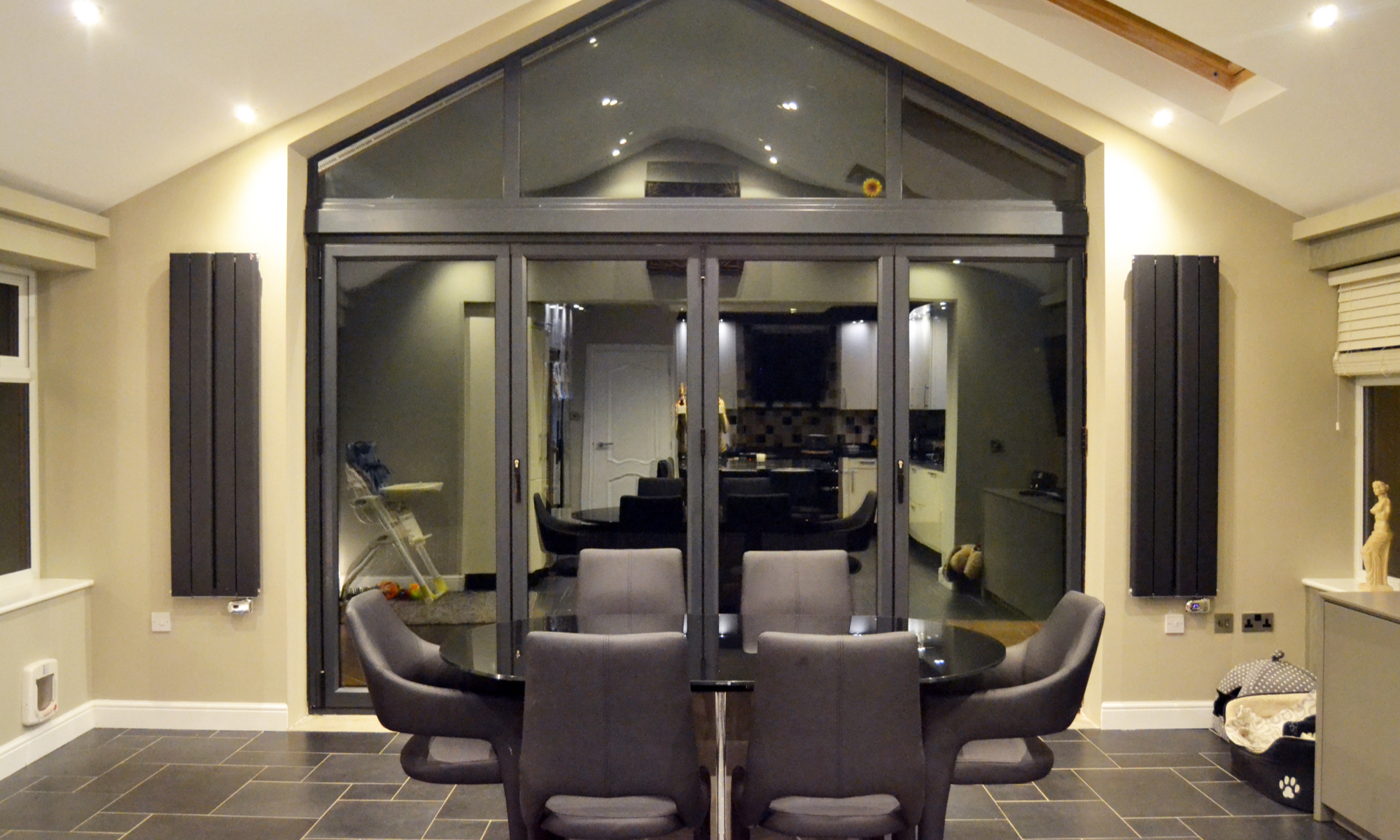

Traditional Column Radiators
If your kitchen has a more classic or industrial feel, our vertical traditional column radiators are an excellent option. These radiators are available in a wide array of special colour finishes, allowing you to add a touch of character and warmth to your space.
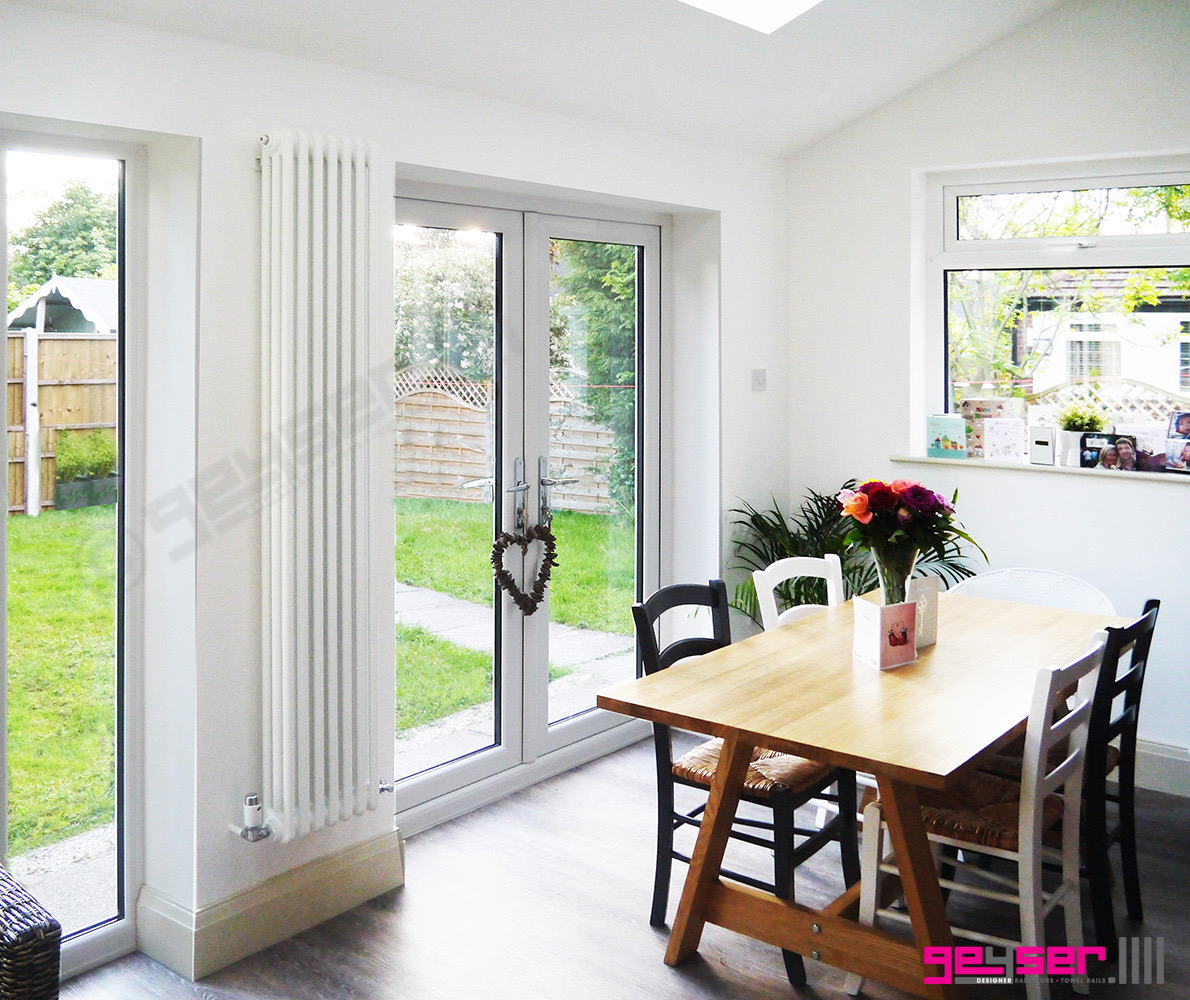

Conclusion: Finding the Perfect Radiator for Your Kitchen
Selecting the best radiator for your kitchen requires a balance of style, functionality, efficiency, and smart technology. Unlike other rooms in the house, kitchens generate their own heat from cooking appliances, which means the heating system must be carefully chosen to complement the existing environment while ensuring optimal comfort and energy efficiency.
Throughout this guide, we've explored key considerations, including radiator styles, placement strategies, material choices, and smart heating options that make your kitchen both warm and stylish.
Key Takeaways:
Space-Saving Radiators Are Essential – Wall-mounted, vertical, and under-unit radiators are excellent solutions for maximizing kitchen space. Heated plinth radiators are particularly useful in compact kitchens.
Material Matters – Aluminium radiators heat up quickly and are energy-efficient, while stainless steel and cast iron offer durability and a premium aesthetic. Choosing the right material ensures longevity and performance.
Smart Heating Enhances Convenience & Efficiency – With Wi-Fi-enabled radiators, programmable thermostats, and zoned heating, modern kitchens can be heated only when needed, preventing energy waste and reducing utility costs.
Aesthetic Appeal is Just as Important – Kitchens are high-traffic, social spaces, so your radiator should complement your interior design. Whether opting for minimalist, contemporary, or industrial styles, there are radiator designs to suit every kitchen.
Future-Proof Your Heating System – Investing in motion-activated heating sensors, voice-controlled integration, and app-based temperature control ensures your kitchen heating remains modern and adaptable to new technologies.
Final Thought: The Best Kitchen Radiator is One That Suits Your Lifestyle
Whether you’re designing a new kitchen or upgrading your heating system, the perfect radiator should fit your space, your energy goals, and your aesthetic preferences. From space-saving plinth heaters to Wi-Fi-controlled smart radiators, the right choice will ensure your kitchen is not just warm, but also an efficient and inviting space.
By considering functionality, energy efficiency, and style, you can transform your kitchen into a comfortable, cost-effective, and modern living space that meets all your heating needs.
Upgrade Your Kitchen with Geyser
Ready to transform your kitchen with a stylish and efficient vertical radiator? Explore Geyser’s extensive collection today. With a variety of designs, colours, and finishes to choose from, you’re sure to find the perfect radiator to complement your kitchen. Visit Geyser and discover how we can help you create a warm and inviting kitchen space.



